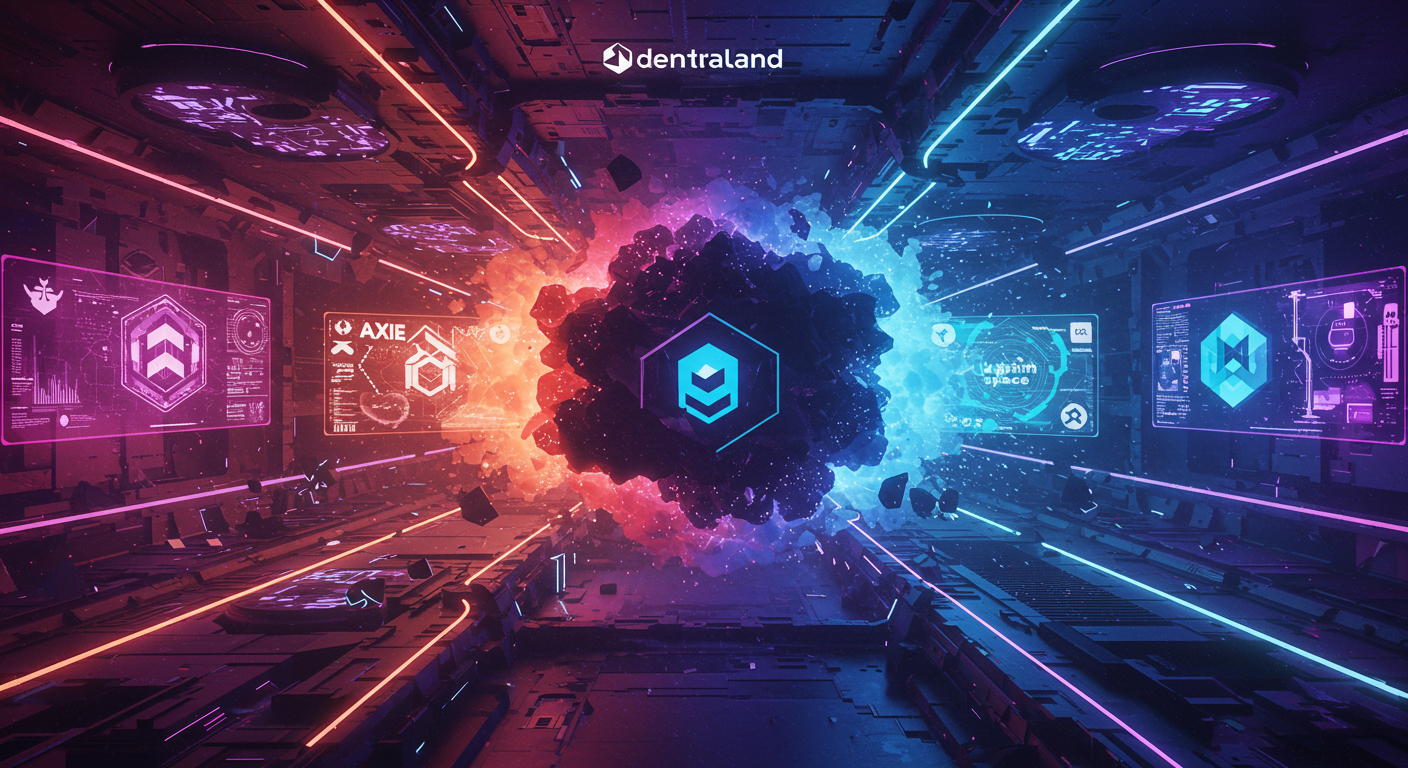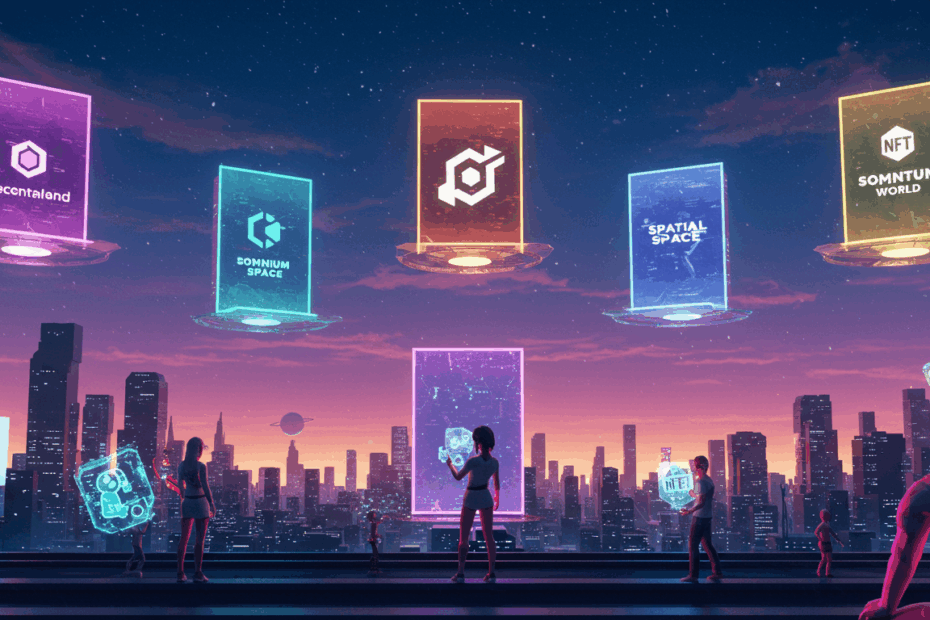Unlock the metaverse! 🚀 Discover the top 5 trending platforms transforming digital ownership & experiences. Your guide is here!#metaverse #web3 #NFT
🎧 Listen to the Audio
If you’re short on time, check out the key points in this audio version.
📝 Read the Full Text
If you prefer to read at your own pace, here’s the full explanation below.
Basic Info

John: Let’s start with the basics of what we’re calling “現在注目されているメタバースプラットフォーム5選,” which translates to the top 5 currently trending metaverse platforms. Based on real-time insights from X posts and reputable sources like CoinDesk and Cointelegraph, these platforms are gaining attention in 2025 for their Web3 integrations. They include Decentraland, The Sandbox, Somnium Space, Spatial, and Hyperfy, as highlighted in various X discussions about open metaverses. Decentraland, for instance, launched around 2017 as an Ethereum-based virtual reality platform where users own and monetize land via NFTs.
Lila: That’s fascinating, John. So, why did these platforms start? From what I’ve seen on X, like posts from users discussing the evolution from games to decentralized worlds, they aimed to solve issues like centralized control in virtual spaces. For example, The Sandbox began in 2011 as a mobile game but pivoted to blockchain in 2018 to empower creators with true ownership. What problem do they collectively aim to solve?
John: Exactly, Lila. The core problem is the lack of user ownership and interoperability in traditional virtual worlds. These platforms use blockchain to enable decentralized economies, where users can buy, sell, and build without a central authority. Somnium Space, starting in 2017, focuses on VR immersion with blockchain for persistent ownership. Spatial, which evolved from its 2016 origins, emphasizes collaborative metaverse experiences, and Hyperfy is noted on X for its browser-based, open-source approach.
Lila: I see how that ties into Web3 principles. When did the buzz really pick up? Posts on X from 2025 mention how the metaverse revolution is just getting started, linking back to earlier hype in 2021-2022, but now with more mature tech in 2025.
John: The initial wave was around 2021 with NFT booms, as per Cointelegraph archives, but 2025 trends on X show renewed interest due to advancements in AI and scalability. They solve scalability and accessibility issues in metaverses by leveraging blockchains like Ethereum.
Lila: Makes sense for beginners like me. So, these aren’t just games; they’re economic systems?
Technology Pillars / Architecture

John: Diving into the tech, the core pillars of these platforms revolve around blockchain for decentralization, NFTs for ownership, and interoperability protocols. For Decentraland, it’s built on Ethereum with MANA tokens for transactions. In the past, it relied on basic smart contracts, but currently, it integrates layer-2 solutions for faster interactions, as discussed in CoinDesk reports.
Lila: Wow, that sounds technical. Can you break down how the architecture evolved? Like, for The Sandbox, it uses voxel-based building on Ethereum, right? X posts mention its shift from centralized servers to blockchain for user-generated content.
John: Precisely. Past architecture for many was centralized, but now they use decentralized protocols like IPFS for content storage. Looking ahead, future visions include cross-chain interoperability, as per official updates, to connect metaverses seamlessly.
Lila: Interoperability is key, I gather from X trends. For Somnium Space, it’s VR-focused with blockchain for land parcels. How does that differ from Spatial’s approach?
John: Somnium emphasizes immersive VR with Web3 ownership, evolving from early prototypes to current blockchain-integrated worlds. Spatial, on the other hand, uses web-based access for broader reach, with plans for deeper NFT frameworks.
Lila: And Hyperfy? Posts on X highlight its open-source nature, making it easier for devs to build on.
Community & Ecosystem
John: The community around these platforms is vibrant, especially on X, where users share sentiments about the metaverse revolution. For instance, posts from verified accounts like Metaverse Worlds in 2025 emphasize ownership and creativity, with high view counts indicating strong engagement.
Lila: I’ve noticed that too. Developer activity is buzzing; X mentions ambassador programs in Decentraland, where creators build events. What about partnerships?
John: Ecosystems include partnerships with brands, as seen in The Sandbox’s collaborations with celebrities. Live X posts from users like MetaDoge in July 2025 discuss routes like innovative experiences in Somnium and Hyperfy, showing positive sentiment.
Lila: Examples? There’s a post praising Decentraland’s Web2-like experience, and another listing top Web3 projects including metaverse ones, with favorites reflecting community interest.
John: Exactly, and Spatial’s community focuses on collaborative spaces, with X discussions on ecosystem growth.
Use-Cases & Integrations
John: Real-world use-cases include virtual real estate in Decentraland, where users currently host events and sell NFTs, as per Cointelegraph.
Lila: Games in The Sandbox let users create and monetize, right? Future integrations might include DeFi for in-metaverse finance.
John: Yes, Somnium Space currently offers VR social hubs, with future plans for AI integrations. Spatial integrates with web tools for meetings, distinguishing current collaborative uses from upcoming metaverse expansions.
Lila: Hyperfy’s browser-based approach currently enables easy access to decentralized spaces, potentially integrating with gaming in the future.
Future Vision & Potential

John: Roadmaps indicate expansions like cross-platform avatars, as per official sites. X creators are optimistic about growth in 2025.
Lila: But there are critical views on X about scalability issues.
John: Balanced perspectives show potential for massive adoption, but with regulatory hurdles.
Risks & Limitations
John: Challenges include scalability on Ethereum, as noted in CoinDesk. Security risks like hacks are concerns.
Lila: X accounts mention regulatory uncertainties, especially in 2025 trends.
John: Tech limitations like high gas fees persist, with experts on X warning about adoption barriers.
Expert Commentary / Analysis
John: Paraphrasing from Cointelegraph, experts see these platforms as key to tokenized economies. An X post from a veteran like ikehaya highlights metaverse as a Web3 area.
Lila: Another from Hokage lists promising Web3 projects, reflecting optimism.
John: This shows mature evolution, but we must watch for real utility.
Recent Trends & Roadmap
John: In the past, hype peaked in 2021. Currently, 2025 X trends show AI integrations. Looking ahead, roadmaps promise interoperability.
Lila: Recent launches include updates in Decentraland, as per official announcements.
FAQ
What is a metaverse platform?
John: A metaverse platform is a virtual space where users interact, own assets, and build economies using blockchain.
Lila: It’s like a digital world blending social, gaming, and finance, powered by Web3 tech.
How do I get started with Decentraland?
John: Create a wallet, buy MANA, and explore the virtual world via their site.
Lila: It’s beginner-friendly with tutorials on official resources.
What makes The Sandbox unique?
John: Its voxel creation tools and user-owned games set it apart.
Lila: It empowers creators with blockchain monetization.
Is Somnium Space VR-only?
John: Primarily VR, but accessible via desktop too.
Lila: Future updates may enhance non-VR access.
How does Spatial differ?
John: It’s more about collaborative web-based spaces.
Lila: Less gaming, more professional metaverse use.
What about Hyperfy’s open-source aspect?
John: It allows devs to customize and build freely.
Lila: Promotes community-driven development.
Related Links
- Official website
- Official X (Twitter)
- Whitepaper / GitHub
- CoinGecko / CoinMarketCap page
Final Reflections
John: After exploring 現在注目されているメタバースプラットフォーム5選 through real-time insights and expert discussion, it feels like a genuine part of the next-generation Web3 infrastructure. What impressed me is its focus on real interoperability, not just buzzwords.
John: I’ll be keeping an eye on how its developer community grows and how real users respond to its tools in the metaverse and beyond.
Lila: Same here! I was surprised how many creators and builders are already experimenting with 現在注目されているメタバースプラットフォーム5選. It made Web3 feel way more practical to me—not just theoretical.
Lila: I’m excited to follow its progress and maybe even test some apps built on it myself. It definitely feels like a project to watch!
Disclaimer: This article is for informational purposes only. Please do your own research (DYOR) before making any decisions.
